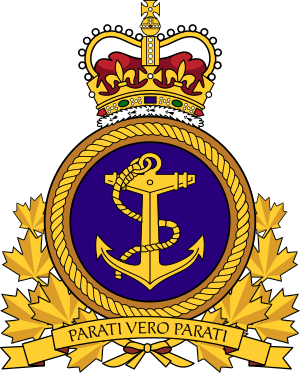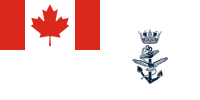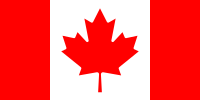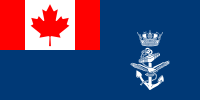Royal Canadian Navy facts for kids
Quick facts for kids Royal Canadian Navy |
|
|---|---|
| Marine royale canadienne | |

Badge of the Royal Canadian Navy
|
|
| Founded | 4 May 1910 |
| Country | Canada |
| Type | Navy |
| Role | Naval warfare, power projection, nuclear deterrence, and sealift |
| Size | 13,600 personnel, 30 ships |
| Part of | Canadian Armed Forces |
| Headquarters | National Defence Headquarters |
| Motto(s) | Latin: Parati vero parati (Ready aye ready) |
| March | "Heart of Oak" |
| Mascot(s) | SONAR (Newfoundland dog) |
| Engagements |
|
| Commanders | |
| Commander-in-chief | Charles III, King of Canada, represented by Governor General, Julie Payette |
| Commander of the Royal Canadian Navy | Vice-Admiral Art McDonald CMM MSM CD |
| Chief Petty Officer of the Navy | Chief Petty Officer 1st Class David Steeves |
| Insignia | |
| Naval ensign |  |
| Naval jack |  |
| Auxilary jack |  |
The Royal Canadian Navy (RCN) is Canada's navy. It is one of three main parts of the Canadian Armed Forces. The RCN helps protect Canada's waters. It also takes part in missions around the world.
As of 2017, the Royal Canadian Navy has 12 frigates, 4 patrol submarines, and 12 coastal defence ships. It also uses 8 unarmed patrol and training vessels. There are 8,500 full-time sailors and 5,100 reserve sailors. About 5,300 civilians also support the navy. Vice-Admiral Art McDonald is the current leader of the Royal Canadian Navy.
Contents
The Royal Canadian Navy started on May 4, 1910. It was first called the Naval Service of Canada. On August 29, 1911, it officially became the Royal Canadian Navy.
Joining the Canadian Armed Forces
In 1968, the RCN joined with the Royal Canadian Air Force and the Canadian Army. Together, they formed the unified Canadian Armed Forces. After this, the navy was known as Maritime Command until 2011.
In 2011, the navy got its historic name back: "Royal Canadian Navy."
The RCN in World Events
The Royal Canadian Navy has played an important role in many major events.
- World War I and II: The RCN served in both the First World War and the Second World War.
- Korean War: They also took part in the Korean War.
- Other Conflicts: The navy was involved in the Persian Gulf War and the War in Afghanistan.
- Peacekeeping: The RCN has also helped with many United Nations peacekeeping missions. They have also joined NATO operations.
The RCN's main jobs include protecting Canada's coasts and waters. They also help with international security. This includes fighting piracy and stopping illegal activities at sea.
Types of Ships
The Royal Canadian Navy uses different types of ships for various tasks.
- Frigates: These are large warships used for many purposes. They can defend against other ships, submarines, and aircraft.
- Submarines: These ships travel underwater. They are used for patrols and gathering information secretly.
- Coastal Defence Vessels: These smaller ships protect Canada's coastlines. They also help with mine countermeasures.
The Royal Canadian Navy has two main bases in Canada.
- Halifax, Nova Scotia: CFB Halifax is on the east coast. It is the main base for RCN units in the Atlantic region.
- Esquimalt, British Columbia: CFB Esquimalt is on the west coast. It is the main base for RCN units in the Pacific region.
Images for kids
-
HMCS Québec, formerly HMS Uganda, was one of many ships used by the RCN in the Second World War. The RCN grew a lot during the war. By 1945, it was the world's fifth-largest navy.
-
HMCS Athabaskan leaving Halifax for the Persian Gulf. It was part of the Coalition forces. Canada sent three ships to support Operation Desert Shield and later Operation Desert Storm.
-
CFB Esquimalt is a main base for the RCN's Pacific units.
-
HMCS St. John's, one of 12 Halifax-class multi-role frigates in the RCN.
-
A Royal Canadian Air Force CP-140 Aurora. This aircraft is used by the RCAF for patrolling the seas.
-
The Halifax Memorial in Halifax, Nova Scotia. It honours Canadian service members who died at sea in both World Wars.
-
The Montreal Clock Tower in Montreal, Quebec. It honours Canadian sailors who died during the First World War.
-
The Royal Canadian Naval Association Naval Memorial in Burlington, Ontario. It remembers members of the RCN and Canadian Merchant Navy who served in the Second World War.
-
The Royal Canadian Navy Monument in Ottawa, Ontario. It honours those who have served, or are serving, in the RCN.
See also
 In Spanish: Marina Real Canadiense para niños
In Spanish: Marina Real Canadiense para niños
















